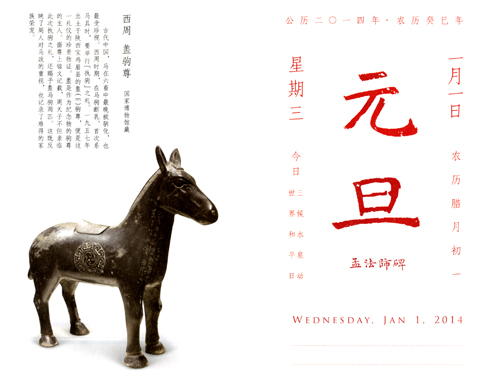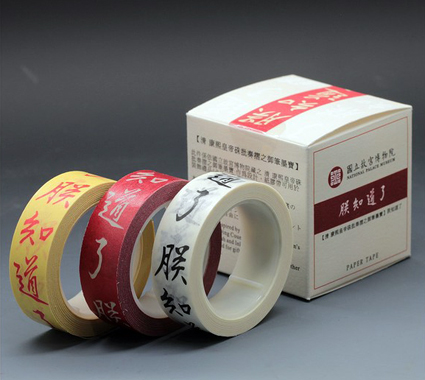
The Calendar at Forbidden City Museum Published by The Palace Museum in Beijing is Very Popular
The fashionable stocks of National Palace Museum at Taipei borrow the lotus ice crack lines of Ru Kiln of North Song Dynasty and imprint the colors of Ru Kiln of South Song Dynasty on the stocks, which become a fad because of its good tastes and fashion and gain popularity among girls. The famous brand D & G fills every costume with the neo-classist, romantic sentiments of the French Revolution, which embodies the special meaning in homage to history. When Bartholdi was influenced by the heroine of Liberty Leading the People and personified her into the Statue of Liberty, when Mona Lisa became the important theme of creation on T-shirts, we have to say that the rare treasure of museums have provided more and more symbolic elements for the development of cultural creative industry. Accordingly, the cultural creative industry has brought the unexpected values and powers to people because of its unique creativity.
Inspiration of “Yilan Experience”
In the eyes of many people, museums, no matter they are of historic, scientific, or other types, would leave the audiences an impression of solemnity and sublimity. That is the inconceivable reason why so many museums are designed with flights of steps. Most people enter museums with passion and admiration and select those treasures that they like and match their tastes to have their eyes feasted. Xiang Yong,vce dean of School of Arts of Peking University, has summarized the values of museum into three categories. The first is the value of admiration; the second is the value of exhibition while the third is the value of experience. In his opinion, if you want to see Mona Lisa, naturally you will go to Louvre and enjoy its beauty amid the ambience, in which the value of admiration works. After the appreciation, you might feel unsatisfied and want to bring something home. Then, the replica of Mona Lisa in medium or small size on the display window will satisfy people’s inner aesthetic needs, in which the value of exhibition was realized. The next thing will be the value of experience in which people are willing to converse with Mona Lisa. In this process, as a media, the museum succeeds in linking consumers to the cultural creative industry. While the value of museum is brought into the full play, the development of the cultural creative industry is promoted as well.
In recent years, with the development of the cultural creative industry, the urban construction undergoes the transformation from the commercial, economic and industrial type to the creative, cultural type. “Yilan Experience”, which is well known all around the world, is just the case that an unknown small village turns out to be the backyard garden whose reputation is known far and wide in Taiwan because of the cultural introduction. We can say that the cultural creative industry has become the important measuring standard of new urbanization construction. In the county of Yilan, there are 50-odd museums of different sizes. The local cultural authorities have planned in a comprehensive way to develop a family of Yilan Museums with Lanyang Museum as its core and rural and folk museums around as its branches. Through the construction of Lanyang Museum, Yilan plans to make further progress with cultural and natural ecologies as the key points. In a sense, the development of an urban museum also decides its urban cultural comprehensive competitiveness and the level of the cultural creative industry’s level to great extent.

“The Emperor Knows” Adhesive Tape is Produced by The Palace Museum in Taipei
Creativity! Creativity!
How to further develop the cultural creative industry of museums has become the hottest topic in the circle. Wang Yongming, professor of Longhua University, chose the derivative products of museums as his study object and gave an analysis of the creative products network of the cultural creative industry. As far as he can see, sensitivity, convenience and flexibility are necessary condition for museums to develop the cultural creative industry. Besides, he puts forward his concrete method of implementation as “maintain—change—select”. He believes it an effective way to maintain those interesting elements out of the antiquities and develop related cultural creative products on their basis. The most typical example is the paper tape “The Emperor knew it” promoted by National Palace Museum at Taipei, which is the combination of common stationery in daily life and the authentic inscription by Emperor Kangxi. This tiny creativity has brought lots of people to the Museum. Many tourists come to the Museum specially to buy this paper tape and even some offer their versions such as “The Empress Orders Silence”, “Here Comes Imperial Edit!” and “Kowtow your Leave” to bring out more creative ones.
The replication and adoption of those rare collections of the museums also becomes the sources of inspiration for the development of the cultural creative industry. For example, the culture of “Happiness” of the Mansion of Prince Gong is highly valued by the deputy director of the Antiquities Bureau of Beijing. The Emperor Kangxi wrote down the Chinese character “Fu” (Happiness) as his best wishes for his grandmother Empress Dowager Xiaozhuang. He also added his imperial seal with the meaning of “As the good fortune descends to earth and happy stars rise high, all the evil spirits must be squashed”. The administrative office of Mansion of Prince Gong chooses the culture of happiness as the key measure and makes full use of it. Those rubbings of “Fu” character and folded fans, ornaments with “Fu” elements are quite popular among tourists. Moreover, the proper adoption and elaboration of some auspicious patterns might be another good way of developing the cultural creative industry of museums.
Sherlock Wood, marketing manager of Victoria and Albert Museum of Britain, believes that the museums should not stand alone but carry out cooperation with the surrounding sites and join in other activities held by the local institutions in order to brand its own image and make the audiences feel at home. Pal Murk, the ex-president of Marketing and Public Relations Special Committee of International Museum Association shares his experiences on the interaction between museums and audiences, “Museums should enhance the capability of the community’s participation and invite the public into daily affair of the museum in order to change them from the passive consumers to the active participants”.














